Welcome
Welcome to the homepage of the Laser Dynamics Laboratory (LDL), a research laboratory launched in 1996 at the Georgia Institute of Technology. LDL houses the most recent lasers and laser spectroscopic equipment for time-resolved studies in the femto-to-millisecond time scale.
The main areas of research at the LDL are centered on:
1. Photothermal Therapy of Cancer
Gold nanoparticles, like metals in general, quickly transfer energy from absorbed light to the lattice which is then lost to the surroundings as heat, processes that my group has studied in great detail. The enhanced optical absorption of plasmonic nanoparticles makes them highly efficient, localized sources of photothermal heating. We have demonstrated that this can be used to selectively kill cancer cells both in vitro and in vivo, with little damage to surrounding healthy cells, by using targeted gold nanorods that absorb light at near-IR wavelengths transparent to the body. The relatively low toxicity of gold nanorods makes photothermal therapy a superior alternative to photodynamic therapy based on molecular dyes.
2. Nano Catalysis
Most of the industrial products at present time involve the use of a catalyst. Thus the field of catalysis is currently billions and billions of dollars industry. Metallic catalysis takes place on the surface, thus catalysis with nanoparticles which have very large surface:volume ratio is expected to be much more effective and thus requires far less material and thus becomes economically profitable. Furthermore, nanoparticles of different shapes are expected to have different catalytic properties. This can open the door to new catalytic processes that produce new material. This is what the El-Sayed’s group realized and worked on. Catalysis with nanoparticles is much more efficient and depends not only on the size and shape of the nanoparticle but also on whether the nanoparticle is solid or hollow!
3. Surface-enhanced and Resonance-enhanced Raman Spectroscopies
Resonance-enhanced Raman spectroscopy takes advantage of the longer lifetime of electronic transitions relative to the virtual state in standard Raman spectroscopy, and allows for the investigation of the vibrational fingerprints of molecules when on resonance with the excitation source. My group used resonance-Raman for over 30 years to study many processes, ranging from solving the Bacteriorhodopsin photocycle to investigate the oxygenation of hemoglobin intermediates. More recently, we began using surface-enhanced Raman Spectroscopy (SERS), which takes advantage of the enhanced electromagnetic fields in the gaps between aggregated plasmonic gold nanoparticles, to obtain the vibrational fingerprint of the nanoparticles’ microenvironment. My group pioneered the use of targeted gold nanoparticles to perform SERS inside single living cells, at low gold concentrations shown to be nontoxic. We have been able to observe cellular dynamics including mitosis, apoptosis, and necrosis as changes in the Raman spectrum over time. Our techniques give us a unique look into biochemistry, which will enable new understanding of chemical mechanisms in living cells.
4. Sensors
Plasmonic nanoparticles are characterized by having the localized surface plasmon resonance (LSPR) spectrum and possessing strong surface electromagnetic plasmonic field. The peak position of LSPR spectrum of any plasmonic nanoparticles depends on the dielectric of the surrounding medium in addition to other physical parameters. The plasmonic field greatly enhances the Raman signal by a factor of over 1010 times. Both the shift of the LSPR peak position upon changing the dielectric function of the surrounding medium and the enhancement of the Raman signal by the plasmonic field are used in the chemical and biological sensing technology.
To see the full list of the LDL publications, please visit Prof. El-Sayed's google scholar page.
The Laser Dynamics Laboratory provides a shared resource for research, encourages collaborations across disciplines, and facilitates the use of laser spectroscopic techniques in new areas of study. The laboratory was formally inaugurated with a symposium and open house in late November 1996. Professor El-Sayed, the director of the LDL and Regents Professor, holds the Julius Brown Chair in chemistry. The funds for establishing the facility came from a Georgia Institute of Technology and a National Science Foundation grant.



